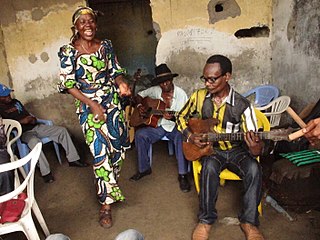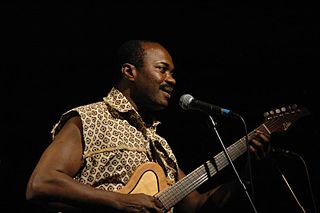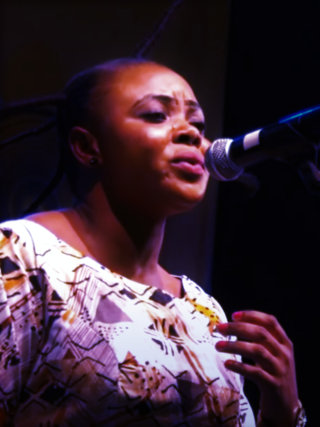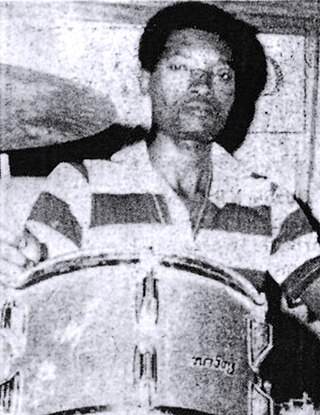
Congolese music is one of the most influential music forms of the African continent. Since the 1930s, Congolese musicians have had a huge impact on the African musical scene and elsewhere. Many contemporary genres of music, such as Kenyan Benga and Colombian Champeta, have been heavily influenced by Congolese music. In 2021, Congolese rumba joined other living traditions such as Jamaican reggae music and Cuban rumba on UNESCO's "intangible cultural heritage of humanity" list.

Soukous is a genre of dance music originating from the Democratic Republic of the Congo and the Republic of the Congo. It derived from Congolese rumba in the 1960s, with faster dance rhythms and bright, intricate guitar improvisation, and gained popularity in the 1980s in France. Although often used by journalists as a synonym for Congolese rumba, both the music and dance associated with soukous differ from more traditional rumba, especially in its higher tempo, song structures and longer dance sequences.

Jules Shungu Wembadio Pene Kikumba, known professionally as Papa Wemba, was a Congolese singer and musician who played Congolese rumba, soukous, and ndombolo. Dubbed the "King of Rumba Rock", he was one of the most popular musicians of his time in Africa and played an important role in world music. He was also a fashion icon who popularized the Sape look and style through his musical group Viva la Musica, with whom he performed on stages throughout the world.

Zaïko Langa Langa is a Congolese rumba band formed in Kinshasa, in December 1969. Established by D.V. Moanda, Henri Mongombe, Marcellin Delo and André Bita, the band evolved from the Orchestre Bel Guide National, which is seen as Zaïko's predecessor.

Ndombolo, also known as dombolo, is a genre of dance music originating in the Democratic Republic of the Congo. Derived from soukous in the 1990s, with fast-paced hip-swaying dance rhythms, often accompanied by upbeat, percussion-driven music, the style became widespread in the mid-1990s and the subsequent decade, dominating dancefloors in central, eastern, and western Africa. It inspired West African popular music, coupé-décalé, Kuduro, and East African dance music.

Congolese rumba, also known as African rumba, is a dance music genre originating from the Republic of the Congo and Democratic Republic of the Congo. With its rhythms, melodies, and lyrics, Congolese rumba has gained global recognition and remains an integral part of African music heritage. In December 2021, it was added to the UNESCO list of intangible cultural heritage.
Bimi Ombale was a Congolese singer, drummer and songwriter. He was a member of the band Zaiko Langa Langa from 1969 to 1988 and its most successful and prolific songwriter.

Pépé Felly Manuaku, also known as Pépé Fely is a Congolese rumba guitarist, songwriter, producer, arranger, bandleader and lyricist from the Democratic Republic of the Congo (DRC). He has been described as the foremost Congolese solo guitarist of his generation. He is a founding member of the iconic groups Zaïko Langa Langa, Les Ya Toupas and Grand Zaïko Wawa. His style of guitar is the last style officially credited as a "School" or Genre of guitar following the styles "Fiesta" created by "Le Docteur" Nico Kassanda and "Odemba" created by "Le Sorcier" Franco Luambo Makiadi. He is credited with establishing the guitar as the lead instrument in contemporary Congolese music introducing Synthesiser, Bouzouki, Advanced Guitar effect pedal techniques, new arrangement and recording techniques.

Jossart N'Yoka Longo is a Congolese singer, songwriter and producer. After starting his career within Bel Guide National in 1969, he became the third member, after Papa Wemba and Félix Manuaku Waku, of the legendary group Zaïko Langa Langa, of which he later established himself as the main leader.

Georges Kiamuangana Mateta, known professionally as Verckys, was a Congolese saxophonist, composer, producer, bandleader, and record executive. A significant figure in the evolution of 20th-century Congolese and African popular music, he is referred to as "Verckys", "Vévé", "the man with the iron lungs" and "Wazola Nzimbu". Kiamuangana was the second Congolese artist to establish and independently manage a record label, Éditions Vévé, through which he brought many Congolese musicians to prominence, including Zaïko Langa Langa, Koffi Olomide, Empire Bakuba, Afrisa International, OK Jazz, Langa Langa Stars, Victoria Eleison, Historia Musica, Orchestre Kiam, and others.
D. V. Moanda was a prominent figure of Congolese music. He was best known for being one of the co-founders, alongside Henri Mongombe, Marcellin Delo and André Bita, of the influential Congolese rumba band Zaïko Langa Langa in December 1969.

Esther Iyenga Mboyo, better known as Iyenga is a Congolese singer-songwriter.

Nippon Banzai is a 1986 studio album by Congolese band Zaïko Langa Langa, released on their ProZal label. The album followed band's pioneering tour of Japan in October 1986, positioning them as the second Congolese musical collective to perform in the country, after Papa Wemba and his band Viva La Musica, who had toured Japan earlier that same year.

Sebene, also spelled seben, is an instrumental section commonly played in Congolese rumba. It is usually played towards the end of the song and is the dancing section where the lead and rhythm guitars take the lead in the dance. It is characterized by the repetition of a specific number of notes during the passage of second chords: one major chord and one-seventh chord, which gives rise to the Lingala derivation "sebene", derived from the English numeral "seven" or its ordinal rendition.
Bakunde Ilondjoko, known as Bakunde Ilo Pablo, was a Congolese drummer, musician and composer best known for being a long-time member of Zaïko Langa Langa. His drumming was characterized by his powerful hitting and mastery of the hi-hat.

Jean-Marie Belobi Ng’ekerme, known professionally as Meridjo Belobi, was a Congolese drummer and songwriter. Known for being a long-time drummer for Zaïko Langa Langa, he is credited as the creator of the Cavacha drum pattern, which gained international recognition and is considered as a major contribution to African music.
Zéphyrin-Alexandre Matima Mpioso, known professionally as Mbuta Matima, was a prominent Congolese guitarist, arranger, music director and songwriter, best known for his influential work with Zaïko Langa Langa, one of the most famous and enduring bands of Congolese rumba.

In the sebene instrumental section of a Congolese rumba song, the atalaku serves as the band's frontman, responsible for actively engaging the audience, building excitement, and augmenting the performance with spirited vocalizations and rhythmic chants. Atalaku often uses fast-paced speech, onomatopoeic sounds, and playful wordplay to captivate listeners and sustain their energy throughout the performance.

Faustin Mangituka Ntaminimo, known professionally as Bébé Atalaku, is a Congolese songwriter and musician whose work with Nono Monzuluku has significantly shaped Congolese music, mainly through his role as an atalaku in Zaïko Langa Langa.
Antoine Pierre-Emmanuel Adoula Monga, professionally known as Doudou Adoula, was a Congolese singer-songwriter, atalaku and composer, best known for his longstanding role in Zaïko Langa Langa.














